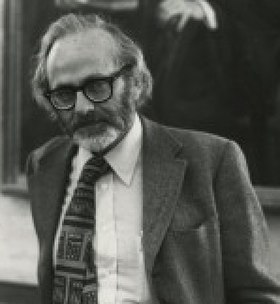David Hubel
| David H. Hubel | |
|---|---|

Torsten Wiesel (left) and Hubel (right), co-recipients of the 1981 Nobel Prize in Physiology or Medicine for their discoveries concerning information processing in the visual system, 1980
|
|
| Born | David Hunter Hubel February 27, 1926 Windsor, Ontario, Canada |
| Died | September 22, 2013 (aged 87) Lincoln, Massachusetts, US |
| Nationality | American-Canadian |
| Fields | Neurophysiologist |
| Institutions | |
| Alma mater | McGill University |
| Known for | Visual system |
| Notable awards |
|
| Spouse | Ruth Izzard (m. 1953) |
David Hunter Hubel (February 27, 1926 – September 22, 2013) was a Canadian neurophysiologist noted for his studies of the structure and function of the visual cortex. He was co-recipient with Torsten Wiesel of the 1981 Nobel Prize in Physiology or Medicine (shared with Roger W. Sperry), for their discoveries concerning information processing in the visual system. For much of his career, Hubel was the John Franklin Enders University Professor of Neurobiology at Harvard Medical School. In 1978, Hubel and Wiesel were awarded the Louisa Gross Horwitz Prize from Columbia University.
Hubel was born in Windsor, Ontario, Canada, to American parents in 1926. His paternal grandfather emigrated as a child to the United States from the Bavarian town of Nördlingen. In 1929, his family moved to Montreal, where he spent his formative years. His father was a chemical engineer and Hubel developed a keen interest in science right from childhood, making many experiments in chemistry and electronics. From age six to eighteen, he attended Strathcona Academy in Outremont, Quebec about which he said, "[I owe] much to the excellent teachers there, especially to Julia Bradshaw, a dedicated, vivacious history teacher with a memorable Irish temper, who awakened me to the possibility of learning how to write readable English." He studied mathematics and physics at McGill University, and then entered medical school there.
In 1954, he moved to the United States to work at Johns Hopkins University School of Medicine as an assistant resident in Neurology. He was later drafted by the army and served at Walter Reed Army Institute of Research (WRAIR). There, he began recording from the primary visual cortex of sleeping and awake cats. At WRAIR, he invented the modern metal microelectrode out of Stoner-Mudge lacquer and tungsten, and the modern hydraulic microdrive, for which he had to learn basic machinist skills to produce. In 1958, he moved to Johns Hopkins and began his collaborations with Wiesel, and discovered orientation selectivity and columnar organization in visual cortex. One year later, he joined the faculty of Harvard University. In 1981, Hubel became a founding member of the World Cultural Council. From 1988 to 1989 he was the president of the Society for Neuroscience.
...
Wikipedia
